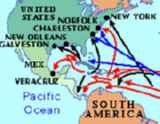|
Our Tribe!
|

African Americans have at various times in United States history been referred to as African, colored, Negro, Afro-American, and black, as well as African American. Exactly what portion of the African American population is of solely African ancestry is not known. Over the past 300 and more years in the United States, considerable racial mixture has taken place between persons of African descent and those with other racial backgrounds, mainly of white European or American Indian ancestry. Historically, the predominant attitude toward racial group membership in the United States has been that persons having any black African ancestry are considered to be African American. In some parts of the United States, especially in the antebellum South, laws were written to define racial group membership in this way, generally to the detriment of those who were not Caucasian. It is important to note, however, that ancestry and physical characteristics are only part of what has set black Americans apart as a distinct group.
African Americans Under Slavery: 1600-1865
The first Africans in the New World arrived with Spanish and Portuguese explorers and settlers. By 1600 an estimated 275,000 Africans, both free and slave, were in Central and South America and the Caribbean area. Africans first arrived in the area that became the United States in 1619, when a handful of captives were sold by the captain of a Dutch man-of-war to settlers at Jamestown. Others were brought in increasing numbers to fill the desire for labor in a country where land was plentiful and labor scarce. By the end of the 17th century, approximately 1,300,000 Africans had landed in the New World. From 1701 to 1810 the number reached 6,000,000, with another 1,800,000 arriving after 1810. Some Africans were brought directly to the English colonies in North America. Others landed as slaves in the West Indies and were later resold and shipped to the mainland.
Slavery in America. The earliest African arrivals were viewed in the same way as indentured servants from Europe. This similarity did not long continue. By the latter half of the 17th century, clear differences existed in the treatment of black and white servants. A 1662 Virginia law assumed Africans would remain servants for life, and a 1667 act declared that “Baptisme doth not alter the condition of the person as to his bondage or freedome.” By 1740 the slavery system in colonial America was fully developed. A Virginia law in that year declared slaves to be “chattel personal in the hands of their owners and possessors for all intents, construction, and purpose whatsoever.”
The principle by which persons of African ancestry were considered the personal property of others prevailed in North America for more than two-thirds of the three and a half centuries since the first Africans arrived there. Its influences increased even though the English colonies won independence and articulated national ideals in direct opposition to slavery. In spite of numerous ideological conflicts, however, the slavery system was maintained in the United States until 1865, and widespread antiblack attitudes nurtured by slavery continued thereafter.
Prior to the American Revolution, slavery existed in all the colonies. The ideals of the Revolution and the limited profitability of slavery in the North resulted in its abandonment in northern states during the last quarter of the 18th century. At the same time, the strength of slavery increased in the South, with the continuing demand for cheap labor by the tobacco growers and cotton farmers of the Southern states. By 1850, 92% of all American blacks were concentrated in the South, and of this group approximately 95% were slaves.
Life on the plantations was hard, and no consideration was given to the cultural traditions of blacks. In the slave market men were separated from their wives, and frequently children were taken from their mothers. Family and tribal links were thus almost immediately cut. Fifty percent of the slaves were owned by 10% of the 385,000 slave owners. This concentration within a limited number of agricultural units had important consequences for the lives of most blacks.
Under the plantation system, gang labor was the typical form of employment. Overseers were harsh as a matter of general practice, and brutality was common. Punishment was meted out at the absolute discretion of the owner or the owner’s agent. Slaves could own no property unless sanctioned by a slave master, and rape of a female slave was not considered a crime except as it represented trespassing on another’s property. Slaves could not present evidence in court against whites. Housing, food, and clothing were of poor quality and seldom exceeded what was considered minimally necessary to maintain the desired level of work. Owners reinforced submissive behavior not so much by positive rewards as by severe punishment of those who did not conform. In most of the South it was illegal to teach a black to read or write.
Opposition by Blacks. All Southern states passed slave codes intended to control slaves and prevent any expression of opposition. Outbreaks of opposition did occur, however, including the Gabriel Prosser revolt of 1800, the revolt led by Denmark Vesey in 1822, the Nat Turner rebellion of 1831, and many smaller uprisings. As a result the substance and the enforcement of repressive laws against blacks became more severe. Blacks were forbidden to carry arms or to gather in numbers except in the presence of a white person.
Free blacks, whether living in the North or South, were confronted with attitudes and actions that differed little from those facing Southern black slaves. Discrimination existed in most social and economic activities as well as in voting and education. In 1857 the Dred Scott v. Sandford case of the U.S. Supreme Court placed the authority of the Constitution behind decisions made by states regarding the treatment of blacks. According to the Dred Scott decision, African Americans, even if free, were not intended to be included under the word “citizen” as defined in the Declaration of Independence and could, therefore, claim none of the rights and privileges provided for in that document.
African Americans responded to their treatment under slavery in a variety of ways. In addition to such persons as Prosser, Vesey, and Turner, who openly opposed the slave system, thousands of blacks escaped from slavery and moved to the Northern United States or to Canada. Others sought ways to retain some sense of individuality and some vestige of their African heritage under difficult circumstances. Still others accepted the images of themselves that white America sought to project onto them. The result in some cases was the “Uncle Tom” or “Sambo” personality, the black who accepted his or her lowly position as evidence that whites were superior to blacks.
In spite of the absence of legal status and the adverse effects of the domestic slave trade, the African American family retained its traditional role in ordering the relations between adults and children. Much religious activity among slaves reflected the influences of African religious practices and served as a means by which slaves could develop and promote views of themselves different from those held by the slave owner. Outside the South, blacks established separate churches and, eventually, denominations within Protestantism, including many black Baptist churches. Another early denominational effort was the African Methodist Episcopal Church, initially called the Free African Society, which was founded (1787) in Philadelphia by Richard Allen.
